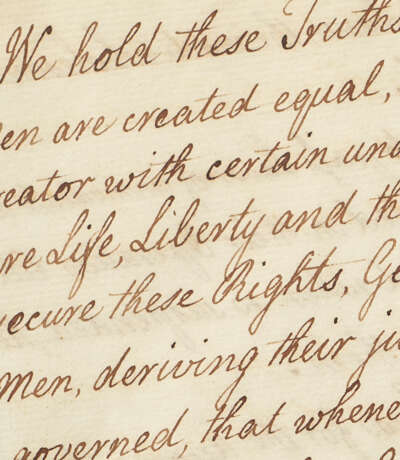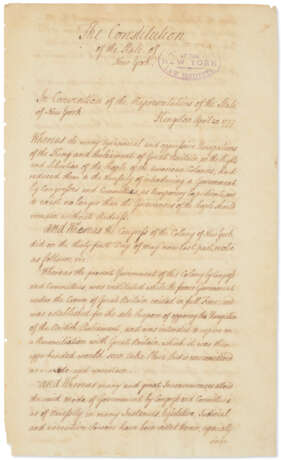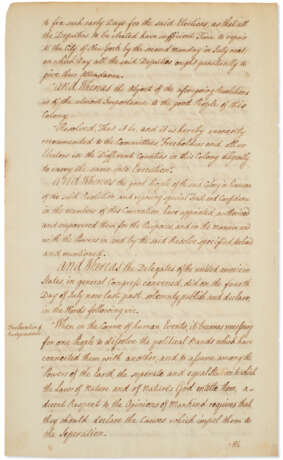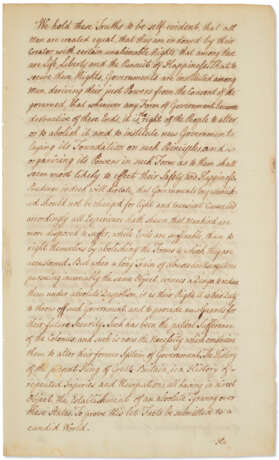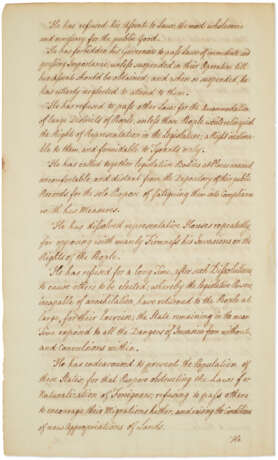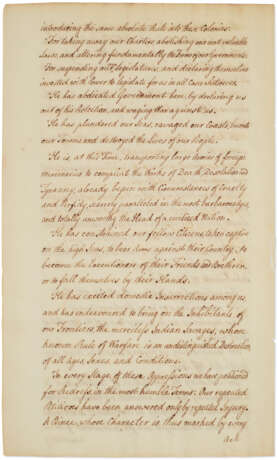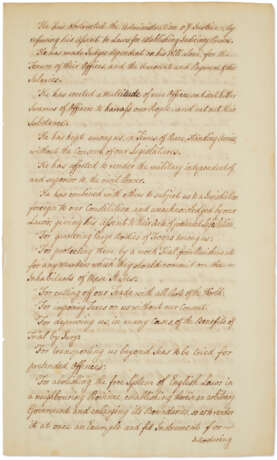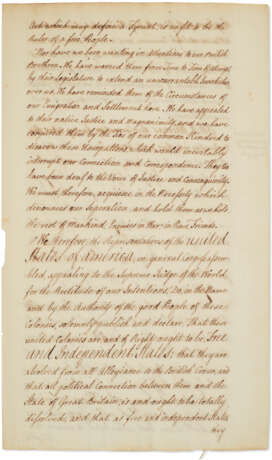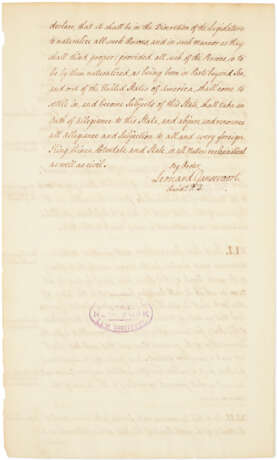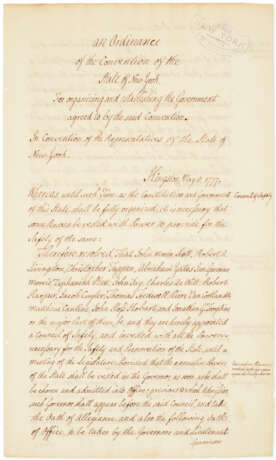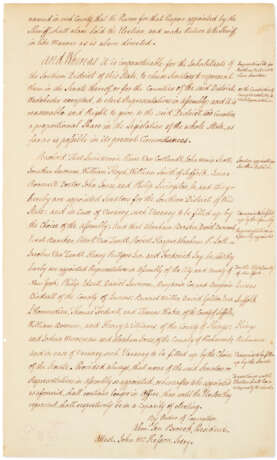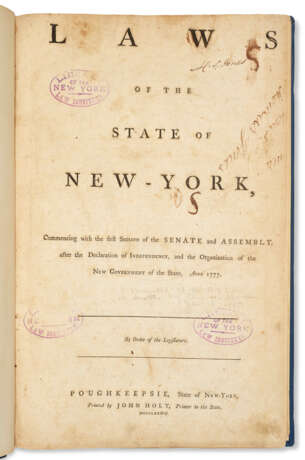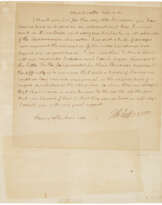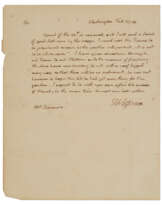ID 1362367
Los 652 | The Jones Declaration of Independence
Schätzwert
$ 2 000 000 – 3 000 000
Samuel Jones, c. 1788
A newly-discovered manuscript of the Declaration of Independence—written in the hand of Samuel Jones of New York who is credited with securing New York's ratification of the United States Constitution by breaking the impasse over the inclusion of a bill of rights.
This is the first time a manuscript version of the Declaration written in the hand of an important participant in the nation’s founding has ever appeared at auction, and the only one known to be held privately.
Jones penned the Declaration as it appears within the text of what stands as the earliest complete manuscript of the 1777 New York State Constitution—the only state constitution to quote the Declaration’s text in full.
Jones likely penned this manuscript in 1788 for use in the New York Ratification Convention and may have been intended to play a similar role that has been suggested for the recently-discovered Sussex Declaration.
THE DECLARATION OF INDEPENDENCE IN THE 1777 NEW YORK CONSTITUTION — [JONES, Samuel (1734-1819)]. Autograph manuscript, "The Constitution of the State of New York, Kingston April 20 1777" containing the full text of the Declaration of Independence. [New York, c. 1788]. [With:] "An Ordinance of the Convention of the State of New-York, For organizing and establishing the Government agreed to by the said Convention … Kingston May 8, 1777…. By Order of Convention, Abm. Ten Broeck, President. Attst. John McKeson, Sec'ry." [New York, c. 1787- 1788]. [Together with and formerly bound in:] Laws of the State of New-York, Commencing with the first Session of the Senate and Assembly, after the Declaration of Independency, and the Organization of the New Government of the State, anno 1777. Poughkeepsie, State of New-York, Printed by John Holt, Printer to the State, 1782.
Manuscript: 39 pages, 371 x 222mm, on laid paper bearing the watermark "Curteis & Sons" (Gravell, WORD.381.1, 1787), with numerous marginal notations in Jones' hand together with several emendations in an unknown hand, post c. 1792, noting the independence of Vermont in reference to legislative apportionment, four marginal library stamps. (Trimmed at left margins, occasional spots of foxing and mild toning). Blue cloth clamshell. Book: Folio (377 x 232mm), ownership signature and other notations in ink and pencil and library stamps on title page, marginal notations throughout and six leaves of manuscript index at the conclusion in Jones' hand (occasional stains and foxing, miniscule loss to lower right corner of page 71). Later blue cloth boards. Blue cloth clamshell.
An 18th century manuscript of the Declaration of Independence, in the hand of Samuel Jones—an unsung hero of the early Republic—included in the text of the earliest known complete manuscript of New York's 1777 Constitution. Jones played a crucial role in securing the ratification of the Constitution while ensuring the Bill of Rights would follow. Jones’s contributions were particularly significant because of New York’s pivotal role in the early Republic. Although he was a Loyalist during the Revolutionary War, with peace secured, he became an active participant in the government of New York, leveraging his legal skills to help rewrite the laws of the state, and in early 1787 introducing, and securing the passage of a statutory bill of rights for the State of New York. But his most famous contribution would be at the New York Ratification Convention of 1788. As an Antifederalist, he played a crucial role in convincing the State of New York to ratify the U.S. Constitution. The debates during the ratification convention were contentious, with Antifederalists led by Governor George Clinton favoring ratification only if a bill of rights were incorporated into the Constitution. As a compromise, Jones proposed altering the phrasing of the Ratification resolution from “on condition that” a bill of rights would follow to “in full confidence that” it would. This critical adjustment helped secure ratification by a narrow margin of 31 votes to 29, ensuring both the Constitution’s success and the enactment of the first ten amendments that became known as the Bill of Rights three years later.
The Declaration of Independence holds a unique place in the New York Constitution, serving as a preamble to the 1777 document. While some other state constitutions mention the enactment of the Declaration of Independence in their preambles, New York boldly enshrined the entire document in text, linking its new government directly to the ideals of independence and natural rights. The discovery of this manuscript emphasizes the Declaration’s role not only as the foundational document establishing a new nation but also as the standard against which all governments "deriving their just powers from the consent of the governed" would be measured.
The Sussex Declaration, discovered in 2017 in West Sussex archives, is the only other known manuscript copy of the Declaration of Independence found in recent years. Its origins and purpose remain a topic of scholarly interest and speculation, but recent scholarship has proposed it may have been commissioned for the Constitutional Convention in Philadelphia. (See Danielle Allen and Emily Sneff, "Golden Letters: James Wilson, the Declaration of Independence, and the Sussex Declaration" Georgetown Journal of Law and Public Policy, 17:1 (Winter 2019), 193-229). Similarly, the Jones Declaration, penned in Jones' own handwriting and with the paper dated to the period of the New York Ratification Convention, aligns closely with the timing and needs of the convention. These factors strongly indicate that it was almost certainly prepared for reference and reading during the New York Ratification Convention by a known participant in the establishment of the republic under the Federal Constitution and a champion of the Bill of Rights.
This is the only eighteenth-century manuscript of the Declaration of Independence known to be held privately, according to the census maintained by Harvard University’s Declaration Resource Project which lists all known printings and manuscripts of the Declaration of Independence from 1776 to 1826.* It identifies only sixteen extant manuscripts of the Declaration of Independence, including drafts and fair copies in the hands of Thomas Jefferson, John Adams, Timothy Matlack, Charles Thomson as well as six in unidentified hands. All of these versions are part of institutional collections and include:
Thomas Jefferson. Fragment of a draft, June 1776
Thomas Jefferson Papers, Library of Congress
Thomas Jefferson. 4 page draft, the original rough draught, June 1776
Thomas Jefferson Papers, Library of Congress
John Adams. Four page draft. June 1776
Massachusetts Historical Society
Thomas Jefferson. 4 page draft, the Lee fair copy, c. July 1776
American Philosophical Society
Thomas Jefferson. 4 page draft, the Washburn fair copy, c. July 1776.
Massachusetts Historical Society
Thomas Jefferson. 4 page draft, the Whyte fair copy, c. July 1776
New York Public Library
Timothy Matlack. 1 page, full text with signatures, engrossed on parchment, bef. 2 August 1776
National Archives
Thomas Jefferson. 6 page draft as part of notes on the Continental Congress, c. 1776
Thomas Jefferson Papers, Library of Congress
Unknown. 8 pages, full text, c. 1776
Gold Star Collection, Clements Library, University of Michigan
Unknown. 8 pages, full text, c. 1776
Geroge Sackville Germain Papers, Clements Library, University of Michigan
Unknown. 8 pages, full text, with signatures of Benjamin Franklin and Silas Deane, c. 1777
Gilcrease Museum
Unknown. 10 pages, full text, 20 January 1778
Parliamentary Archives
Thomas Jefferson. 13 pages, draft as part of notes copied for James Madison, c. 1783
Library of Congress
Unknown. 1 page, full text including signers, on vellum, c. 1780s
West Sussex Record Office
Unknown. 1 page, fragment of draft, no date
The Thomas Paine National Historical Association
This extraordinary manuscript underscores Samuel Jones’ direct connection to the foundational principles expressed by the Declaration of Independence while highlighting his critical role in ratifying the U.S. Constitution. Jones’ role is all the more profound when we consider that over the course of the Revolutionary War, Jones remained loyal to the British crown. But with independence secured in 1783, he was keen to be of service to his state and young nation. By illuminating Jones' contributions—particularly his role in the key compromise that ensured New York’s ratification in 1788 that paved the way for the Bill of Rights—this manuscript underscores his indispensable role in the establishment of the Republic. As one of the few tangible links to Jones’s legacy, this manuscript offers a powerful opportunity to reevaluate and celebrate his achievements, ensuring that his contributions to the success of the American Republic are recognized, while also underscoring the profound links between the Declaration, The Constitution and the Bill of Rights.
Provenance: Samuel Jones (1734-1819) — his son, David S. Jones (1777-1848, ownership signature on title page of Laws of New-York) — Presented to the New York Law Institute, 19 January 1887 by Charles W. Sloane (d. 1929, note on title page of Laws of New-York) — deaccession.
__________________
*Note that the Declaration Resources Project has yet to undertake a full census of manuscript versions of the Declaration of Independence recorded in town books, especially in New England. Being public property, these versions will likely never come to market.
| Künstler: | Thoma Jefferson (1743 - 1826) |
|---|---|
| Kategorie: | Servicen |
| Kategorie des Auktionshauses: | Briefe, Dokumente und Manuskripte, Bücher und Handschriften |
| Künstler: | Thoma Jefferson (1743 - 1826) |
|---|---|
| Kategorie: | Servicen |
| Kategorie des Auktionshauses: | Briefe, Dokumente und Manuskripte, Bücher und Handschriften |
| Adresse der Versteigerung |
CHRISTIE'S 20 Rockefeller Plaza 10020 New York Vereinigten Staaten | ||||||||||||||
|---|---|---|---|---|---|---|---|---|---|---|---|---|---|---|---|
| Vorschau |
| ||||||||||||||
| Telefon | +1 212 636 2000 | ||||||||||||||
| Fax | +1 212 636 4930 | ||||||||||||||
| Nutzungsbedingungen | Nutzungsbedingungen | ||||||||||||||
| Versand |
Postdienst Kurierdienst Selbstabholung | ||||||||||||||
| Zahlungsarten |
Banküberweisung | ||||||||||||||
| Geschäftszeiten | Geschäftszeiten
|
